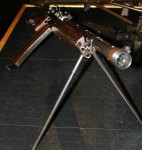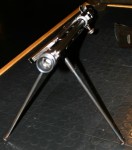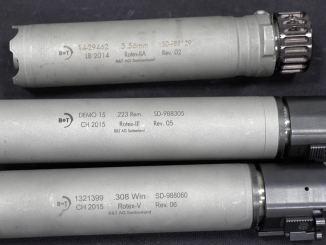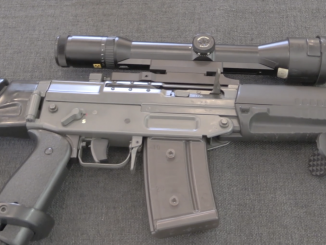The KE-7 was a short-recoil, open-bolt light machine gun developed by SIG Neuhausen between the World Wars. It was offered for sale in basically any cartridge a nation might request, and were sold primarily to China and Latin America. I have a full Vault page on the KE-7 with a number of manuals, and today I also have these photos, from the collection of Reed Knight:
Note that the standard magazines held 25 rounds, and this gun has an extended magazine fitted. I don’t know exactly how large it is, but I would guess 40 rounds. I have not been able to find reference to these magazines in any literature.










Neither fish(MG) nor fowl(rifle), interesting however. One thing which sticks out is Swiss fancyyyy.
I’m with Denny on this one, however, in support of a squad armed with bolt-action rifles (and being used against a similarly equipped foe), any automatic rifle, regardless of sustained fire ability, would provide some advantage. The BAR and the BREN served well past their prime, and even today, the RPK types fill a similar role. Still, belt-feed and a quick-change barrel in a slightly heavier package would be far more useful in the squad support role. On a lighter note, this does resemble the Australopithecine ancestor of my beloved PE 57 (Stgw 57) that is sitting beside me as I type this.
Like the BAR, the KE-7 is not a “true” LMG. Rather, it is an example of a related breed, the machine rifle.
What most people don’t understand about the MR is that it doesn’t have a quick-change barrel or belt feed because for its mission, it doesn’t need either one. Its job is to provide quick suppressive fire on the move in the advance or retreat, while the LMG’s job is to provide sustained overwatch fire.
The MR is intended to be used like a standard infantry rifle for the most part, in single-shot mode, capitalizing on its heavy barrel to provide better accuracy for long shots. The full-auto fire mode is reserved for when a point target at short-to-medium range needs to be “suppressed” hard– such as an MG nest that’s about to rake your section as you throw in the assault. You give them about half the magazine in short four-or-five-round bursts. In this mode, that 40-round box would be a definite help.
The “pull-through” trigger also reflects this part of its mission. No fumbling with a selector switch, just point and pull- hard.
Machine rifles were fairly common up to WW2. During and after which, they were largely rendered obsolescent by the advent of the submachine gun and the assault rifle, which gave every man in the section the ability to perform the MR man’s mission.
Machine rifles continue to be built although they are seldom recognized as such. The M14A1 SAW version of the M14 in 7.62x51mm NATO was a perfect example, as is the RPK in 7.62x39mm. You could argue that the Ultimax 100 falls into this category, as well, because it feeds from a drum rather than a belt, although it has a quick-change barrel and only fires full-auto. The Knight 7.62x51mm would also qualify if it were selective-fire.
IMHO, if I were given a choice of only one long arm to carry into a battle, I believe I could do a lot worse than a BAR or an M14A1. Or even a KE-7, for that matter.
cheers
eon
The problem with a dedicated support weapon being magazine-fed with a fixed barrel is that once a position is taken by assault, it usually must be held from a determined counter-attack. That is when the GPMG comes into its own, in being able to switch from an offensive to a defensive role immediately. The downside is the weight of the gun and its ammunition, spare barrels, etc. (Having carried the M60 in the field, I am well aware of its shortcomings.) That being said, weapons such as the KE-7, the BAR, and its modern counterparts such as the RPK and the L86 LSW do serve a useful function at the squad level as a complement to, rather than a replacement for, the GPMG. Weapons such as the Ultimax, M249 SAW, and the HK MG4 seem to be the current fashion in the squad support role, bridging the gap between the automatic rifle and the GPMG (as was the role of the Stoner 63 LMG in limited use in Vietnam). There are also the lighter weight versions of the 7.62 belt-feds, such as the M60 E4, the Pecheneg, and the HK 21, the HK being, at least in concept, a good combination of manageable weight and heavy firepower (albeit at the expense of controllability). In the end, they all have their assets and their liabilities. As for the KE-7, I am sure it is as fine a weapon, quality-wise, as anything in its class (I am a fan of Swiss firearms).
@ Eon & Doc :
Thanks very much for the wonderfully enlightening comments about the machine rifle / light support weapon issue. All I can add to this is that the M16HB SAW of my time, which was supposed to provide a magazine-fed automatic weapons back-up to the squad infantry rifles, fell woefully short of its intended role. It was lacking in sustained firepower, obviously did not have a quick-change barrel, and was mechanically not up to the task in terms of reliability or durability. In other words, it was a tactically well-intentioned but ill-conceived failure of the then-popular universal arms concept. M16 / M4 / AR fans might deplore what I am saying, but nothing is ever going to change the harsh reality of the facts.
We reverted to the previous concept of M16’s in the squad infantry rifle role backed up by the ubiquitous 7.62mm FN MAG58 GPMG with great success. In recent years, more appropriate SAW’s have come along that fit the bill, so I am sure the TO & E has changed accordingly.
I’m a fan of the MAG- among other things, we’re the same age. I find it mildly ironic that our replacement (finally!) for that (bleeped)-up M60 is actually two years older than the ’60.
Whatever the new SAW turns out to be, I hope they stick with 7.62×51 or a comparable round for it. Even with heavyweight bullet loads, the 5.56x45mm is seriously limited in long-range capability (beyond 400 meters). While this isn’t a problem for the individual rifleman (see “assault rifle concept”), the SAW gunner has to be able to suppress point or small-area targets out to at least 800, to deal with support units taking the section under fire. As any 11-Charlie knows, mortars can ruin your whole day, and machine gun nests are an old-fashioned but effective method of making hamburger out of recon units.
Unless the SAW can reach out and touch someone beyond the range of the rifleman’s weapon, the only alternative is to call for fire support from higher. I’m all for this; my “dream” is armed drones orbiting over the TIC area, and each squad leader having an IPad that he can bring up the map on, point to a position (say, an enemy mortar setting up), right click and scroll, and left click on “SEND FIRE HERE”. One of the drones unloads a Hellfire on the coordinate.
Click. Bang. Surprise, Threat, you’re dead.
Until we get that far, or even after, I want the SAW to have at least the range and engagement envelope of a sniper rifle. Just in case. A smart guy with an SVD or equivalent probably won’t feel so smart when he takes the section under fire from 700 meters, if the response is a flock of 7.62×51 “knock it offs” hammering his position.
cheers
eon
That makes it at least two of us on FW who were born in 1958. My two favorite GPMG’s of all time are the MAG58 and PKM, with the latter just edging out the former on my list due to its lighter weight and added controllability. Otherwise, the two are very closely comparable in my estimation.
Chinese Examples (Cal 7,9mm) are visible at the Junshi Bowuguan ( Soldiers Museum) on Chang’An Lu (Beijing). Along with a lot of other Very nice, rare, and occasionally Mis-labeled LMGs and MGs etc.
DocAV
DocAV, it sounds as if you’ve had the privilege of having visited this interesting museum. If you don’t mind my asking, do you have any photographs which you might be willing to share on FW? Thanks very much.
I saw some interesting comments on 7.62 Bren v M60 by an ex-ADF troopie. He favoured the Bren due to no links to get tangled in dense jungle and box mags feeding more reliably in filth than the M60.
WE are going a bit OT here, but as a Former carrier of an M60, and previously having used a Bren, I much preferred the “pig”…the sheer volume of Fire over an area given by the M60 far outweighs the “non tangling” capabilities of the Bren, which was heavy, limited to what filled mags one (and the rest of the section) could carry, and the Inherent “small cone of fire” produced by the Bren ( Accuracy). The Idea of the M60 was a follow-on of the German MG tactic of the use of the MG34 and then the MG42…lay down such a barrage of fire at a high rate, that the Enemy’s heads are kept down whilst your supporting Riflemen move up and engage the enemy at CQ. A German Rifle section was simply there to carry extra ammo for the MG crew.
The same technique was used in SVN with the M60…every other Infantryman carried 2-3 belts of ammo ( up to 300 rounds) ready to “throw over” to the Pig-gunner as required. And to protect the Belts from dirt, foliage, branches etc, the Belts were slipped into sleeves made initially by cutting up the Black plastic Li-los supposed to be used as “blow up mattrass” on patrols ( US M1956 Equipment). Given the success ( and cost) of cutting up Military Issue Lilos, black flexible PVC tube was later issued to cover the ammo.
(Aussies in SVN)
Doc AV
Was there a reason behind the single-stack mag? Granted, the small mag does hold more than the BAR’s mag. Although it only holds 20rds, the BAR’s mag was double-stack, meaning it was shorter, a feature that is pointed out as being rather important since it feeds from the bottom and would often be used in the prone firing position. Getting back on point, did the KE7 have a single-stack mag just for guaranteed reliability?
It’s not a single stack mag…
Hmm. I don’t know where I got that impression, must have misread. My mistake.